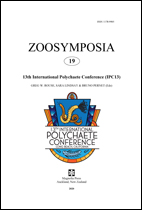Abstract
A new spionid polychaete was discovered in deep-sea sediments in the eastern Mediterranean Sea during an expedition by the Ocean Exploration Trust. Specimens were collected by the E/V Nautilus in August 2012 off Turkey, at a depth of 2216 m on the Anaximander Seamount at the Amsterdam mud volcano site. Cores were taken from sediments covered with microbial mats. The new species belongs to the Pygospiopsis-Atherospio Group, which has unusual neuropodial hooks, modified neurosetae in some anterior setigers, and branchiae in middle body segments that are broad, flattened, and fused to the dorsal lamellae. The new species is assigned to a new genus and species, Aciculaspio anaximanderi n. gen., n. sp., and is unusual in having a reduced setiger 1 lacking notosetae; well-developed pre- and postsetal lamellae that encompass the neurosetae and notosetae; notopodial lamellae free from the branchiae in anterior setigers that become fused and flattened in middle and posterior segments; unidentate hooded hooks in both noto- and neuropodia; neuropodial spines in setigers 4–10; and a pygidium with three anal cirri. Aciculaspio anaximanderi n. gen., n. sp. is the first species in the Atherospio-Pygospiopsis Group collected from a deep-water cold seep habitat.
References
Blake, J.A. (1983) Polychaetes of the family Spionidae from South America, Antarctica and adjacent seas and islands. Biology of Antarctic Seas XIV. In: Antarctic Research Series, 39, 205–288.
https://doi.org/10.1029/AR039p0205
Blake, J.A. (1996) Chapter 4. Family Spionidae Grube, 1850, including a review of the genera and species from California and a revision of the genus Polydora Bosc, 1802. In: Blake, J.A., Hilbig, B. & Scott, P.H. (Eds.), Taxonomic Atlas of the Santa Maria Basin and Western Santa Barbara Channel. Vol. 6. Annelida Part 3. Polychaeta: Orbiniidae to Cossuridae. Santa Barbara Museum of Natural History, Santa Barbara, pp. 81–223.
Blake, J.A. & Arnofsky, P.L. (1999) Reproduction and larval development of the spioniform Polychaeta with application to systematics and phylogeny. Reproductive Strategies and Developmental Patterns in Annelids. Hydrobiologia, 402, 57–106.
https://doi.org/10.1023/A:1003784324125
Blake, J.A. & Maciolek, N.J. (2018) New species and records of Uncispionidae and Pygospiopsis (Polychaeta, Spionidae) from deep water off the east and west coasts of North America, the Gulf of Mexico, the Antarctic Peninsula, and Southeast Asia. Zootaxa, 4450 (2), 151–195.
https://doi.org/10.11646/zootaxa.4450.2.1
Blake, J.A., Maciolek, N.J. & Meißner, K. (2017) 7.4.1 Family Spionidae Grube, 1850. Pp. 1–103, In: Purschke, G., Böggemann, M. & Westheide, W. (Eds.), Handbook of Zoology. Annelida. Volume 2: Annelida Basal groups and Pleistoannelida, Sedentaria II. i–ix, 1–465. De Gruyter, Berlin. [On line edition]
https://doi.org/10.1515/9783110291681-001
Duperron, S., Halary, S., Lorion, J.,Sibuet, M. & Gaill, F. (2008) Unexpected co-occurrence of 6 bacterial symbionts in the gill of the cold seep mussel Idas sp. (Bivalvia: Mytilidae). Environmental Microbiology, 10, 433–445.
https://doi.org/10.1111/j.1462-2920.2007.01465.x
Gofas, S. (2005) Geographical differentiation in Clelandella (Gastropoda: Trochidae) in the northeastern Atlantic. Journal of Molluscan Studies, 71, 133–144.
https://doi.org/10.1093/mollus/eyi016
Grube, AE. (1850) Die Familien der Anneliden. Archiv für Naturgeschichte, Berlin, 16, 249–364. [https://biodiversitylibrary.org/page/32498980]
Laubier, L. & Ramos, J. (1974) Polydora guillei sp. nov. nouvelle espèce de Polychète spionidien en Méditerranée occidentale. Vie et Milieu, 24 (3A), 479–486. [https://wwwphp.obs-banyuls.fr/Viemilieu/images/Archives_1950-2002/vie-et-milieu/VOLUME_1974_24_fasc3_A.pdf]
Lykousis, V., Alexandri, S., Woodside, J., de Lange, G., Dählmann, A., C. Perissoratis, C., Heeschen, K., Ioakim, Chr., Sakellariou, D., Nomikou, P., Rousakis, G., Casas, D., Ballas, D. & Ercilla, G (2009) Mud volcanoes and gas hydrates in the Anaximander mountains (Eastern Mediterranean Sea). Marine and Petroleum Geology, 26, 854–872.
https://doi.org/10.1016/j.marpetgeo.2008.05.002
Mackie, A.S.Y. & Duff, A.L. (1986) Atherospio disticha gen. et sp. nov. (Polychaeta: Spionidae) from Loch Tuirnaig, west coast of Scotland. Ophelia, 25, 139–146.
https://doi.org/10.1080/00785326.1986.10429745
Maciolek, N.J. (1985) A revision of the genus Prionospio Malmgren, with special emphasis on species from the Atlantic Ocean, and new records of species belonging to the genera Apoprionospio Foster and Paraprionospio Caullery (Polychaeta, Annelida, Spionidae). Zoological Journal of the Linnean Society, 84, 325–383.
https://doi.org/10.1111/j.1096-3642.1985.tb01804.x
Meißner, K. & Bick, A. (2005) Atherospio guillei (Laubier & Ramos, 1974) comb. nov. (Polychaeta: Spionidae) and closest relatives. Zoologischer Anzeiger, 244, 115–123.
https://doi.org/10.1016/j.jcz.2005.07.001
Murtey, M.D. & Ramasamy, P. (2016) Sample Preparations for Scanning Electron Microscopy. In: Janecek, M. & Kral, R. (Eds.), Modern Electron Microscopy in Physical and Life Sciences. IntechOpen, London, pp. 161–185.
Olu-Le Roy, K., Sibuet, M., Fiala-Medioni, A., Gofas, S., Salas, C., Mariotti, A., Foucher, J.-P. & Woodside, J. (2004) Cold seep communities in the deep eastern Mediterranean Sea: composition, symbiosis and spatial distribution on mud volcanoes. Deep-Sea Research I, 51, 1915–1936.
https://doi.org/10.1016/j.dsr.2004.07.004
Perissoratis, C., Ioakim, Chr., Alexandri, S., Woodside, J., Nomikou, P., Dählmann, A.D., Casas, D., Heeschen, K., Amman, H., Rousakis, G. & Lykousis V. (2011) Thessaloniki Mud Volcano, the Shallowest Gas Hydrate-Bearing Mud Volcano in the Anaximander Mountains, Eastern Mediterranean. Journal of Geological Research, 2011, Article 247983, 1–11.
https://doi.org/10.1155/2011/247983
Raineault, N.A., Ramey-Balci, P.A., Shank, T.M., Bors, E., Duman, M., Ürkmez, D. & Tüzün, S. (2013) Exploration of the Anaximander Mountains: Mud Volcanoes, Cold-Seep Communities, and Cold Water Corals, Pp. 30–35. In: Bell, K.L.C. & Brennan, M.L. (Eds.), New frontiers in ocean exploration: The E/V Nautilus 2012 field season and summary of Mediterranean exploration. Oceanography, 26 (1), supplement, 64 pp.
https://doi.org/10.5670/oceanog.2013.supplement.01
Reuscher, M.G. & Fiege, D. (2016) Ampharetidae (Annelida: Polychaeta) from cold seeps off Pakistan and hydrothermal vents off Taiwan, with the description of three new species. Zootaxa, 4139 (2), 197–208.
https://doi.org/10.11646/zootaxa.4139.2.4
Southward, E.C., Andersen, A.C. & Hourdez, S. (2011) Lamellibrachia anaximandri n. sp., a new vestimentiferan tubeworm (Annelida) from the Mediterranean, with notes on frenulate tubeworms from the same habitat. Zoosystema, 33 (3), 245–279.
https://doi.org/10.5252/z2011n3a1
Sturany, R. (1896) Zoologische Ergebnisse VII. Mollusken I (Prosobranchier und Opisthobranchier; Scaphopoden; Lamellibranchier) gesammelt von S.M. Schiff “Pola” 1890–1894. Denkschriften der Kaiserlichen Akademie der Wissenschaften, Mathematische-Naturwissenschaftlischen Classe, 63, 1–36, pl.1–2.
Taviani, M. (2014) Chemosynthesis in the Mediterranean Sea. Pp: 69–83. In: Goffredo, S. & Dubinsky, Z. (Eds.), The Mediterranean Sea: Its history and present challenges, Springer, Dordrecht, pp. 69–83.


